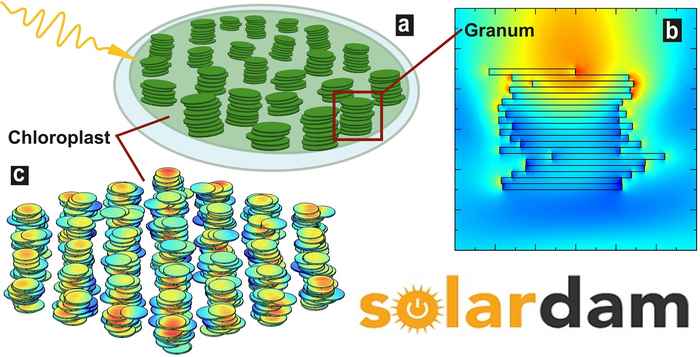Photosynthesis at nanoscale
14 January 2019

Photosynthesis, the process in plants that converts light energy into chemical energy, is crucial for the plant’s life (and ultimately for ours) and is therefore studied intensively by biologists, chemists and physicists. In so-called ‘higher plants’, plants that have a vascular system to transport water and minerals, the light-dependent reactions of photosynthesis occur in a membrane inside the plant’s chloroplast that is called the thylakoid membrane.
Intermediate regime
The thylakoid membrane shows nanoscale features comparable in size to the wavelengths of sunlight. Recently it became evident that, because of this nanoscale structure, light absorption in the membrane cannot simply be described by modeling the infalling light using the optics of straight light rays. The wave nature of light plays a crucial role and therefore a full wave investigation is needed.
A team of researchers led by UvA-physicist Dr Antonio Capretti, working in the Optoelectronic and Nanophotonic Materials group of Prof. Tom Gregorkiewicz and sponsored by the Solardam UvA-VU grant, in collaboration with another Solardam posdoc, Dr Drew Ringsmut from the group of Prof. Roberta Croce from VU, has now addressed this open issue of photosynthetic systems. The team was able to prove that there exists an intermediate nanoscale regime of energy transfer, in between the macroscopic light transfer and the excitation energy transfer at the much smaller protein level.

Counterintuitive
The newly discovered nanoscale regime was characterized rigorously, and in doing so it was shown that the thylakoid membrane indeed has nanophotonic functionalities. An important role in these functionalities is played by the ‘grana’ in the membrane – small stacks of nanoscale layers that interact with the infalling light, see figure 1. It was found that because of this structure inside the membrane and the naturally varying illumination, the light distribution evolves across the chloroplast in ways that seem very counterintuitive and were hitherto unexpected. The results were published in Nature – Light: Science & Applications this week.
Reference
Nanophotonics of higher-plant photosynthetic membranes, A. Capretti, A. K. Ringsmuth, J. F. van Velzen, A. Rosnik, R. Croce and T. Gregorkiewicz. Light: Science & Applications, volume 8, article 5 (2019).